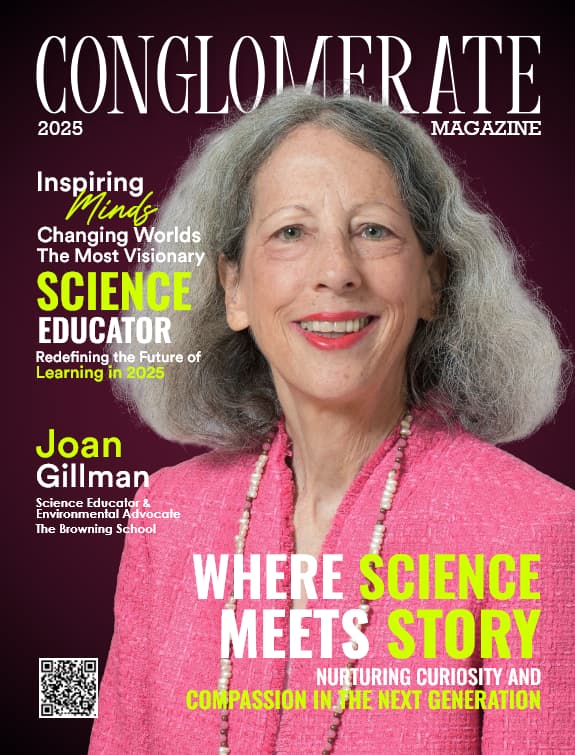In the gleaming towers of Dubai’s business district, where ambition meets innovation, Imran Nawaz has carved out a reputation as one of the region’s most formidable strategic minds. As Chief Strategy Officer at Heden Group, he represents a new generation of leaders who don’t just navigate change they architect it.
His journey reads like a masterclass in cross-industry excellence, spanning aviation’s precision-driven culture, the fast-paced world of food and beverage, healthcare’s patient-centric focus, and logistics’ relentless pursuit of efficiency. Each sector has contributed to a strategic toolkit that transcends traditional industry boundaries, creating a leader uniquely equipped for today’s interconnected business landscape.
“Strategic vision starts with a clear sense of purpose—why the transformation matters and who it’s meant to serve,” Imran reflects on his approach to business transformation. This philosophy has guided him through some of the most challenging restructuring projects across multiple continents, consistently delivering results that surprise even seasoned industry veterans.
THE ANATOMY OF BOLD TRANSFORMATION
Imran’s defining moment came when he faced a mid-sized services company trapped in a cycle of declining margins and stagnant growth. Traditional consulting wisdom might have suggested incremental improvements, but Imran saw an opportunity for radical repositioning.
His solution was audacious in its simplicity: transform the company from a generic service provider into a specialized, value-driven solution partner in a high-growth vertical, while simultaneously overhauling operations through digital transformation.
The results spoke volumes about his strategic acumen. The repositioning allowed the company to command premium pricing and attract higher-value clients, while operational improvements cut delivery times by 30% and significantly boosted customer satisfaction scores. It wasn’t just a turnaround—it was a complete reimagining of what the business could become.
“I encourage my teams to challenge the status quo and think beyond conventional solutions,” Imran explains, highlighting his approach to innovation leadership. This mindset has become his signature, whether he’s restructuring underperforming divisions or forging strategic partnerships that reshape entire market segments.
MASTERING THE ART OF CROSS-INDUSTRY EXCELLENCE
What sets Imran apart in today’s crowded consultancy landscape is his proven ability to extract value from diverse industry experiences and apply them across sectors. His work spans aviation’s asset-intensive operations, food and beverage’s margin-sensitive environment, healthcare’s compliance-heavy framework, and logistics’ efficiency-driven culture.
Each industry has taught him invaluable lessons. Aviation showed him the importance of precision and regulatory navigation. Food and beverage demonstrated the power of agile operations and customer experience. Healthcare emphasized the critical nature of compliance and stakeholder management. Logistics revealed the competitive advantage of operational excellence and scalability.
“Often, solutions from one industry can inspire innovation in another,” Imran notes, describing how he applied predictive analytics from aviation maintenance to healthcare scheduling, dramatically improving efficiency. This cross-pollination of ideas has become his competitive edge, allowing him to see opportunities that industry-specific experts might miss.
The approach requires what Imran calls “deep industry immersion”—a commitment to understanding not just the business mechanics but the cultural nuances, regulatory landscape, and stakeholder expectations that define each sector. “You can’t lead effectively in any industry without deeply understanding its dynamics,” he emphasizes, describing his methodology of engaging with frontline teams, customers, and regulators before developing strategic solutions.
FINANCIAL ACUMEN MEETS STRATEGIC VISION
Imran’s approach to P&L management reflects his broader strategic philosophy: maintain rigorous visibility while staying agile enough to pivot when market conditions shift. In volatile environments, he focuses on scenario planning, modeling different market conditions to ensure organizational resilience across multiple potential futures.
One of his most impactful financial strategies involved completely restructuring a company’s pricing and customer segmentation model. The existing one-size-fits-all approach was leaving significant revenue opportunities unexploited. Through detailed analysis, his team discovered that high-value clients were receiving the same pricing as lower-volume accounts.
The solution required courage and precision. They introduced a tiered, value-based pricing model with premium service bundles for high-tier clients while maintaining standardized offerings for lower-tier customers. The revenue impact was immediate and substantial, demonstrating how strategic thinking can unlock hidden value within existing customer relationships.
“We focus on optimizing what we can control: operational efficiency, working capital, pricing strategy, and customer retention,” Imran explains his approach to managing financial performance in uncertain markets. This disciplined focus on controllable variables has consistently delivered results across different market conditions and industry cycles.
FORGING PARTNERSHIPS THAT RESHAPE MARKETS
Imran’s expertise in mergers and acquisitions reflects his broader strategic approach: deals must create genuine value beyond financial engineering. His most notable success involved structuring a joint venture between a logistics company and an e-commerce platform to streamline last-mile delivery across GCC markets.
The partnership addressed a classic market inefficiency. The e-commerce company had rapid growth but lacked reliable delivery infrastructure, while the logistics company had the infrastructure but needed access to high-volume B2C routes. Rather than a traditional supplier-client relationship, Imran proposed an integrated ecosystem approach.
His role extended far beyond deal structuring. He developed the business case and financial model, navigated cross-border regulatory approvals, and oversaw the integration of systems and teams. The challenges were significant—aligning different organizational cultures, harmonizing customer experience standards, and negotiating intellectual property ownership.
The results validated his approach. Delivery success rates improved from 78% to over 95% within six months, revenue from e-commerce logistics grew by 40% year-over-year, and the partnership model was successfully replicated in two additional regions.
“A successful acquisition is not just about a good price—it’s about strategic clarity, financial discipline, cultural alignment, and operational readiness to deliver impact beyond the transaction,” Imran reflects on his M&A philosophy.
LEADING THROUGH COMPLEXITY AND CHANGE
Imran’s leadership philosophy is built on a foundation of inclusion, empowerment, and results-driven accountability. Working across multicultural environments has taught him that diversity becomes a competitive advantage when properly channeled.
His approach to fostering high-performing teams centers on establishing unified vision while respecting cultural differences. “Multicultural teams often outperform homogeneous ones when they’re empowered to bring their unique insights into collective decisions,” he observes, describing how he leverages diverse perspectives for problem-solving and innovation.
During large-scale transformations, his methodology emphasizes structured collaboration through clear governance frameworks while maintaining agility to adapt as conditions change. He builds central transformation offices, defines cross-functional workstreams, and creates decision-making frameworks that manage interdependencies efficiently.
The cultural dimension of transformation leadership cannot be overlooked. Imran has learned that technical excellence must be paired with cultural integration to achieve sustainable change. “I promote inclusion and mutual respect across functions and geographies,” becomes not just a management philosophy but a practical requirement for transformation success.
ANTICIPATING THE FORCES OF DISRUPTION
Looking toward the next five years, Imran identifies several converging trends that will fundamentally reshape business landscapes. Artificial intelligence and automation will transform everything from customer service to supply chain management. Environmental, Social, and Governance factors will evolve from reporting requirements to strategic drivers of brand value and market access.
“The next five years will reward businesses that are tech-enabled, purpose-driven, talent-focused, and globally aware,” Imran predicts, emphasizing that success will require embracing disruption as catalyst rather than threat.
His approach to scenario planning integrates these disruptive forces into strategic modeling. He develops multiple plausible future scenarios—from best-case to highly disruptive environments—and stress-tests current strategies against each possibility. This methodology transforms long-term planning from static documentation into a proactive leadership tool.
The geopolitical dimension adds another layer of complexity. Global supply chains, regulatory frameworks, and market strategies will be increasingly influenced by regional tensions and protectionism. Businesses will need unprecedented agility to diversify risk and localize operations in response to shifting global dynamics.
THE ENTREPRENEURIAL EDGE IN CORPORATE LEADERSHIP
Imran’s entrepreneurial background has fundamentally shaped his approach to corporate leadership. The entrepreneurial mindset taught him to lead with vision, agility, and unwavering focus on value creation, regardless of organizational size or complexity.
“Entrepreneurship taught me to always look for opportunities where others see limitations,” he explains, describing how this perspective influences everything from market entry strategies to organizational restructuring initiatives.
The entrepreneurial experience developed his bias for action and end-to-end accountability. In corporate environments, he encourages teams to act decisively, take calculated risks, and own results rather than just activities. This approach has proven particularly valuable during crisis management and rapid transformation initiatives.
Resource constraints in entrepreneurial settings taught him innovation through necessity—doing more with less, simplifying complexity, and challenging conventional approaches. These skills translate directly into corporate environments where efficiency and innovation drive competitive advantage.
DEVELOPING THE NEXT GENERATION OF GLOBAL LEADERS
Imran’s advice to aspiring global leaders reflects his own journey across industries, cultures, and business challenges. The foundation begins with developing a genuinely global mindset that respects cultural, political, and economic differences while maintaining core values and strategic clarity.
“Great global leaders are great communicators,” he emphasizes, describing the importance of inspiring and aligning diverse teams across geographies and time zones. This requires authenticity combined with the ability to tailor messages to different audiences and contexts.
Cross-functional and cross-cultural collaboration becomes essential in today’s interconnected business environment. The most effective leaders build relationships that transcend traditional boundaries, creating value through diverse perspectives and shared objectives.
Continuous learning represents not just professional development but survival necessity. “The world is evolving fast—through technology, geopolitics, sustainability demands, and more,” Imran observes, emphasizing that curiosity and adaptability separate successful leaders from those who become obsolete.
Perhaps most importantly, global leadership requires purpose and resilience. “Know what you stand for. Use your influence to build inclusive, responsible businesses that contribute to long-term value—not just profit,” becomes both moral imperative and practical business strategy.
A BLUEPRINT FOR TRANSFORMATION LEADERSHIP
As business environments become increasingly complex and interconnected, leaders like Imran Nawaz provide essential guidance on navigating uncertainty while driving meaningful change. His career demonstrates that transformation leadership requires technical expertise paired with cultural intelligence, strategic vision combined with operational excellence, and global perspective grounded in local understanding.
His influence extends beyond individual consulting engagements to shape industry standards and leadership development across multiple sectors. Through his strategic roles, he influences organizational direction at the highest levels. Through his mentorship and thought leadership, he develops future executives who understand both global dynamics and local execution requirements.
“Innovation is a cornerstone of my leadership approach—it’s not just about introducing new ideas but about creating an environment where continuous improvement and forward-thinking are part of the culture,” Imran reflects on his leadership philosophy.
The challenges facing tomorrow’s business leaders will require exactly the kind of cross-industry expertise, cultural fluency, and strategic agility that Imran has developed throughout his career. His example demonstrates that sustainable transformation requires leaders who can think globally while executing locally, who can navigate complexity while maintaining clarity, and who can drive change while building consensus.
As organizations continue evolving in response to technological disruption, regulatory change, and shifting stakeholder expectations, the demand for transformation leaders who combine strategic vision with operational excellence will only intensify. Imran Nawaz’s career provides a compelling blueprint for developing these capabilities and applying them across diverse business contexts.
The future belongs to leaders who can see opportunities where others see obstacles, who can build bridges across cultural and functional boundaries, and who can create value for all stakeholders while driving organizational success. In an era of unprecedented change and complexity, this blueprint for transformation leadership has never been more relevant or more necessary.







